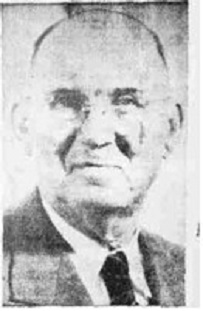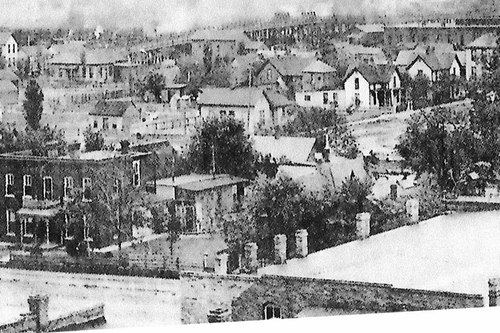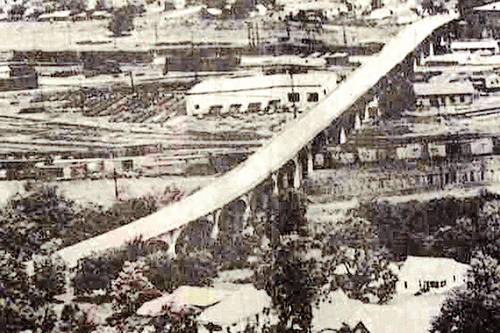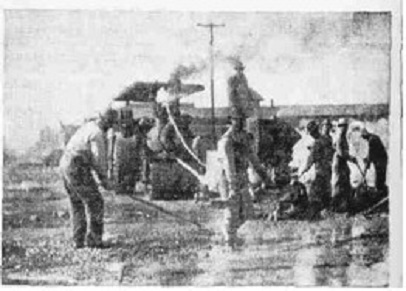
The Denison
Herald
Sun, 26 Feb
1961
State's
Senior County Engineer Retires Here After Rare Career
A
career in public road work stretching from the split-log drag
maintenance of dirt trails to the modern four-lane super-highway will
come to a climax March 1 with the retirement of the oldest county
engineer in Texas.
Heber M.
Scott, a resident of Denison since
1904, will end 43 years as county engineer of Grayson and a much
longer career in road construction and maintenance in this area.
Starting
in his late teens, Scott helped build the first, macadamized road in
Texas, from Denison to Carpenter's Bluff, and figured in some of the
first street paving in Denison and many miles of the first surfaced
roads in this county.
Scott
holds the longest service tenure of any employe in the history of the
county, with years to spare.
The
70-year-old veteran has seen books full of history made in the methods
and science of road maintenance and construction. And he has found a
thrill in every minute of it.
ENJOYED IT
ALL
"I would
have retired earlier, at least a couple of years ago," he declares,
"but I was having too much fun in my
work."
Born at
Leonard
Feb. 6, 1891, he came to Denison with his family 57 years ago and
attended public schools and the famed Harshaw
Business Academy. He
topped off his schooling with a four-year correspondence course in
engineering, reinforced by a lot of practical experience in lhat field.
One
of his earliest jobs was helping remodel the late Security Building
from a wholesale hardware plant, for which it originally was erected,
into an office structure.
As a
youngster he gave little thought
to it, but Scott kept rendezvous with destiny in several respects,
including the epochal landing of the Annie P on Red
River north of
Denison.
His father,
who then operated a transfer service, sent him
to the river to haul in two wagonloads, 6,000 pounds of grindstones
that had been shipped by boat, to the Hall-Leeper Hardware Co. here.
That was in 1905.
PIONEER
ROADS
Scott kept
another date
with history in his first road building work. Through the summer of
1912 he worked as a chairman and later as bridge and culvert inspector
for Road District No. 1, the first in Grayson County.
Embracing
Denison and a northeast corner of the county, this district had voted
$250,000 in bonds for the surfacing of 10 miles of streets in the city
and 20 miles of country roads, including the history-making Carpenter's
Bluff strip.
Scott
recalls that eight men who worked for the
epoch-marking road district still survive here, including Oscar Boren,
a foreman: J. E. Foster, carpenter foreman; S. O. Freeman, who "didn't
quit working when he became foreman"; F. E. Vaughan, foreman; Jess
Cook, now of Pottsboro, a concrete worker; Joe Cassell, a hauler; and
Nath Walcer, Negro road grader operator "who could blade a rock surface
as pretty as you ever saw."
The first
gravel surfaced roads that
replaced dirt trails were 10 feet wide, with a 6 inch layer of clay and
gravel. Scott doesn't remember whether they outlasted the debt they
entailed, but does recall that they "definitely were hailed as a big
improvement in those days."
CRUDE
EQUIPMENT
There
weren't any of the mechanical monsters that make small chores today of
major road construction work.
"The
only power, outside of teams, we had was steam engines which pulled
graders, rollers, and the big plows." Scott recalls. "All dirt was
moved with slips, wheeled scrapers, elevating graders, and bottom-dump
wagons all pulled by teams, preferably mules. We hitched as many
teams in tandem as were needed to move the load."
For some
time after Scott got into the business the then common practice of
using prisoners for road work continued.
"The
prisoners were hauled, as many as 20 at a time, to work sites in huge
wagon cages, which also served as their sleeping quarters. Four or five
armed guards stood watch at all times. The prisoners didn't give us
much trouble as you might think, but neither did they set any records
as workmen."
One of the
unique techniques recalled by
Scott was mixing concrete, something that is done in a continuous
operation today by giant machines that spew out broad concrete paths.
He
remembers that when Gandy street was paved about 1914 all of the
concrete was mixed on room-sized platforms, much in the manner that a
do-it-yourself home-owner today might mix a small batch of concrete for
a step.
SHOVELS
KEPT BUSY
"The
sand, gravel, and
cement were dumped in windrows," Scott explains, "and a whole army of
shovel wielders would start mixing the dry ingredients, with water then
added gradually.
"As crude
as the process was, we whipped up
some concrete that workmen today are finding pretty tough when they rip
it out for rebuilding jobs."
Scott
recalls that Frank Lee, a Negro now employed by the Goodman Co., was
one of the workmen on the Gandy street project.
Before
he got in the groove as county engineer, Scott flitted back and forth
between jobs with the city as assistant engineer, with the interurban
line, and in the engineering department of the Katy, which was widening
curves and otherwise beefing up its track for the inauguration of the
Texas Special as a blistering-fast passenger run.

During one
of
his hitches at city hall, he helped plan the old viaduct, which was
dismantled a few years ago. But, he won't accept blame for the design
of the viaduct, which started on one street, cut diagonally across a
block, and landed on another, producing two tight corners that proved a
bane to later traffic.

Denison's first viaduct
| 
Denison's second viaduct
|
Source : The Herald Democrat
Work on Denison's viaduct causes a look back to its history
by Donna Hunt
January 08, 2012
...Denison's
first viaduct was in the very early days. A wooden structure
carried a street car track and other traffic across across the Austin
Avenue route. People living and working north of Morgan Street
had no trouble coming and going, but those living south of Morgan had a
problem. The Katy's Roundhouse. shops and switch yards stretched
from Lamar Avenue on the east to Mirick Avenue on the west and that
meant a detour for those in South Denison to get to town in the early
days.
That problem was somewhat solved in the 1880s, according to
Jack Maguire in his book, "Katy's Baby" , when the wooden viaduct
was built. It carried tracks for the "dummy line" and the first
mule-powered streetcar as well as a place for pedestrians to
walk. Horses and wagons also probably crossed over the "yards" to
get to town...
The Rest of the Denison Viaduct Story
by Donna Hunt
January 11, 2012
...second
viaduct...Denisonians living in the south part of town were served by
wooden viaduct that in pictures looked a littl shaky from its begining
in the early 1880s until about 1915. Before the wooden structure
was built, those living in thearea south of town had to go
the long way around to get down town. Transportation wasn't
plentiful in those days and for many that meant a lot of walking.
The wooden viaduct was a lot safer in many instances.
But by
1915 the old viaduct with its tracks for the "dummy line" and the first
mule-powered streetcar along with a small walkway for pedestrains had
outlived its usefullness. When talk began about needing a new
viaduct, a controversy arose over where to put a new two lane concrete
structure. City leaders were divided in their acceptance of plans
for the span to begin on Rusk Avenue and end on Austin Avenue.
In
fact, opposition almost forced the city into a special election until
the council took some fast action to prevent it, saying there were no
funds for such an election. At that time a viaduct fund collected
by a special tax levy to build a viaduct over the Katy shops, had only
$5,527 in it.
Mayor Alexander Acheson said that a viaduct as planned
by the city and railroad would cost not less than $60,000 and possibly
$75,000. He said it would take two years to build. It's not
known if money in that special viaduct fund helped build the new span.
The
council issued a special letter to Denisonians, outlining reasons for
the crooked viaduct. Opening words of the letter were "The
council declines to change the location of the viaduct."
Their minds were made up...
The letter continued....the building of the viaduct would have to be postponed indefinitely.
It
may have been the "postponed indefinitely" statement that finally
changed the minds of the people of Denison. Those living on the south
side of town were anxious to have easier access to downtown even though
the viaduct would have a break-neck crook in the span that later became
a deathtrap to many people. Other residents were finally
convinced at how important the viaduct would be to the city....
While
the viaduct was completed as planed from Austin to Rusk avenues, the
oppositio's argument turned out to be true and the viaduct became a
nightmare for travelers from the very beginning.
Even pedestrains
complained that they didn't feel safe walking across the crooked span.
In those days, fewer people had cars and there were a lot of
walkers coming and going to work across the viaduct...
Fortunately
by 1954 the old viaduct was showing its age with signs of decay.
Thanks to the Texas Highway Department, a new $800,000 shortcut
to downtown was opened by way of the Austin Avenue viaduct that started
and ended on Austin Avenue. That structure was a blessing to many
Denisonians. For one thing, it had four lanes instead of two and
it was STRAIGHT!
On November 26, 1954 at 2:45 p.m. barriers to the
center aisle were removed, opening the span without fanfare or even a
ribbon-cutting ceremony....

Scott's
first job with the county was in
1916 as assistant, to the then county engineer, Julian C. Field, who
also was a Denisonian. Field and Scott are the only two men to hold the
county engineer post. Son of a pioneer Denison physician, Field later
was a highway contractor and owned a sand and gravel firm here. His
widow still lives here.
CIRCUITOUS
ROUTES
During his
tenure as assistant county engineer, Scott helped build the
first county-wide system of gravel roads, financed by a $962,000 bond
issue. In all, 235 miles of roads were built, reaching into every
community of any importance.
He recalls
that surveying public
roads routes in those days was largely a matter of following existing
trails and property lines, "and going by practically everybody's house."
He
was on the ground floor of more Grayson road history in 1917, when he
served as resident engineer for a road district, created in the
Hagerman to vote all of $10,000 for 6-1/2 miles of new gravel
paving.
Several
years earlier he served as assistant engineer during
re-construction of the Colbert toll bridge. The span was swept away by
the 1908 flood and a ferry was used for years until the structure could
be rebuilt.
After
a few months as resident engineer on a road
construction program in Carter County, Okla.. Scott became county
engineer of Grayson May 26, 1918, and has held the post since.
A
high point in his career was surveying routes for the county's first
system of concrete roads, built after a 1927 bond issue. This still is
the framework of the county's present highway system.
Scott
remembers that he was working on a city paving job when he and Miss
Nondas Whiteacre were married Dec. 30, 1912. "I wasn't earning enough
money to afford a wife, but we got married anyhow," he chortles.
MOTHER
STILL LIVES
The
Scotts, who reside at 2219 Loy Lake Road, have three sons, Lewis, Roy,
and H. M. Scott Jr., all partners in a paving firm and a daughter, Mrs.
B. K. Burleson, also of Denison.
Also still
very much present
and accounted for at the ripe age of 94 is Scott's mother, Mrs. Minnie
T. Scott, whose husband spent a number of years as a furniture merchant
here.
When Scott
sees the traffic-jammed thoroughfares here
today, he finds it difficult to remember that he started out planning
streets principally for horse and buggy use.
"There were
six cars in Denison then," he recalls.
What
passed as cardinal highway routes had names instead of numbers, the
most popular in these parts being the Jefferson Highway, the "Pine to
Palm Route". Two others through this area were the King of Trails and
Ocean Highway.
Whether
they're 10-foot gravel trails or
four-lane expressways, public roads are closely interwoven with the
lives of the people they serve, and Heber Scott is happy to have
devoted a long and eventful career in that field.
Dallas News
18 Dec 1961
Death Takes
Heber Scott,
Grayson
Engineer 43 Years
DENISON,
Texas (Sp.) - Heber M. Scott, 71, who retired this
year after
spending 43 years as Grayson County engineer, died in a
hospital
here Monday after a 9 day illness.
Funeral
will be at 3 p.m. Wednesday at the Brafcher Funeral Chapel with burial
in Fairview Cemetery.
Mr.
Scott's career in public road work stretched from the split-log drag
maintenance of dirt trails to the modern 4-lane super-highways. At the
time of his retirement, he held the longest service tenure of any
employe in the history of Grayson County.
He hauled
two wagon
loads of merchandise from the Annie
P when the craft made its historic
voyage up Red River to Denison in 1905.
Mr. Scott
was born
Feb. 6, 1891, at Leonard. His, mother, now 95, still lives in
Denison. He was married to Miss Nondas Whiteacre Dec. 30, 1912, in
Denison.
Mr. Scott
was associated with his three sons in H. M.
Scott and Sons, asphalt contractors, for years. He was a member of the
First Christian Church and a deacon. He was a member of the Texas
Society of Professional
Engineers.
At one time
he was assistant engineer of the Texas Electric Interurban Line, was
with the engineering department of the Katy Railroad
and worked with a Denison firm.
He was
educated in Leonard and
Denison and attended the Harshaw Business Academy, topping his studies
with a correspondent course in engineering.

Photo
caption:
EARLY
PAVING PROJECT
H. M. Scott Sr., who took this picture, was serving as
city inspector when a strip of East Main street was paved in 1912. The
steam roller at the rear did extra duty by furnishing steam to operate
the concrete mixer in the foreground. Much of the concrete used in
street paving at that time was hand-mixed on huge platforms.

Sherman
Democrat
18 Dec 1961
Obituary
Notices
Former
County Engineer Dies
DENISON
-- H.M. Scott Sr., 70, of Denison, retired Grayson county engineer,
died at 2:20 a.m. Monday in a Denison hospital. He became critically
ill nine days ago.
Funeral
services will be held at 3 p.m.
Wednesday in Bratcher Funeral Chapel. The Rev. Jess Pugh, pastor of the
First Christian Church, will conduct the services. Burial will be in
Fairview Cemetery.
The family
will be at the funeral chapel from 7 to 9 p.m. Tuesday.
Mr.
Scott was born Feb. 6, 1891, in Leonard, the son of Mr. and Mrs. T. M.
Scott, On Dec 30, 1912, he married Miss Nondas Whiteacre in Denison.
After retiring as county engineer, Mr. Scott became associated with his
sons in the asphalt contract business. He was a deacon in the First
Christian Church, and a member of the church and the Society of
Professional Engineers. He retired on March 1 of this year after 43
years as county engineer.
Survivors
are his wife; three sons, H.
M. Scott Jr., Lewis Scott and Roy Scott; a daughter, Mrs. Francene
Burleson; his mother, Mrs. Minnie Scott, 93, and eight grandchildren,
all of Denison, a niece; and two cousins, Mrs. Tola Montgomery of
Sherman and Rhome Carr of Fort Worth.
Contributed by Suzie Henderson
Biography
Index
Denison History

